How to cite this page Comment citer cette page
Items
-
1735, Statue of William III financed by James Macrae James Macrae, Governor of Madras and a great admirer of William III, paid an unknown artist to create a statue of the king, and presented it to the people of Glasgow. The statue was erected in Tongate, in Glasgow.
-
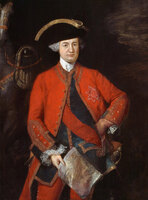 1762, Thomas Gainsborough paints a portrait of Robert Clive The artist Thomas Gainsborough was one of the most eminent British painters of the late eighteenth century and generally known for his landscapes and portraits of British aristocrats. He did in fact paint subjects related to slave societies in the Caribbean and of enslaved people. In or around 1772, he completed an oil painting depicting Robert Clive in a military general's uniform, displaying a document that he is holding in his hand. Although the National Army Museum dates this portrait to around 1764, notes from an old India Office catalogue suggest 1762. This would have been the period when Gainsborough was resident in Bath. Little further information is available about the process of commissioning in the many published biographies of the artist. The majority of these studiously ignore all his work related to colonial subjects.
1762, Thomas Gainsborough paints a portrait of Robert Clive The artist Thomas Gainsborough was one of the most eminent British painters of the late eighteenth century and generally known for his landscapes and portraits of British aristocrats. He did in fact paint subjects related to slave societies in the Caribbean and of enslaved people. In or around 1772, he completed an oil painting depicting Robert Clive in a military general's uniform, displaying a document that he is holding in his hand. Although the National Army Museum dates this portrait to around 1764, notes from an old India Office catalogue suggest 1762. This would have been the period when Gainsborough was resident in Bath. Little further information is available about the process of commissioning in the many published biographies of the artist. The majority of these studiously ignore all his work related to colonial subjects. - 1763, James MacArdell creates an engraving of a portrait of Robert Clive by Gainsborough
-
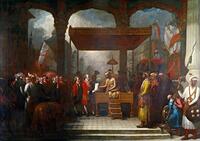 1765, The Grant of Diwani
1765, The Grant of Diwani - 1769, Famine of Bengal
-
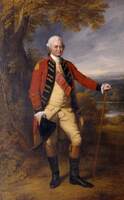 1770 or thereabouts, Nathaniel Dance-Holland paints a full-length portrait of Robert Clive In our around 1770, Nathaniel Dance-Holland painted a full-length portrait of Robert Clive. This portrait is currently most likely at Powis castle. The portrait poses Clive in a idyllic British country landscape, leaning casually on a walking stick.
1770 or thereabouts, Nathaniel Dance-Holland paints a full-length portrait of Robert Clive In our around 1770, Nathaniel Dance-Holland painted a full-length portrait of Robert Clive. This portrait is currently most likely at Powis castle. The portrait poses Clive in a idyllic British country landscape, leaning casually on a walking stick. -
1773 or after, Nathaniel Dance-Holland paints a portrait of Robert Clive The National Portrait Gallery's website says about this painting: "The prototype of this popular portrait by Dance is presumably the full-length in the collection at Powis Castle. The portrait shows Clive in uniform with the ribbon and star of the order of the Bath, with a battle scene in the background. More detailed information on this portrait is available in a National Portrait Gallery collection catalogue, John Kerslake's Early Georgian Portraits (1977, out of print)."
- 1773, Robert Clive's actions in Bengal, India are examined by a Parliamentary Committee
-
1774, Assembly of the Blackboy clock on Kendrick Street Paul Hawkins Fisher described the assembly of the clock in Notes and Recollections of Stroud (1871): "In the house immediately below the passage, John Miles, a watchmaker, formerly lived; and on the front of it he set up a clock, having a large dial-face, and the figure of a n****- boy with a bell before him, on which he sounded the hours with a club. This, it is believed, was the greatest noise, actual or metaphorical, the watchmaker ever made in the world. But he boasted of vast mechanical abilities; and told the writer, then a youth, that he possessed the secret of perpetual motion: and when standing with him at his door, he pointed to a heavily-laden timber-carriage, with a long team of horses passing up the street, and said he could construct a machine that would take up the carriage, timber and horses, throw them into the air, and turn them round for ever and ever! As may be supposed, this foolish boast had an effect on the writer’s young mind contrary to what was intended; for it convinced him that Miles was ignorant both of the proper objects of mechanical science, and of the laws of matter and motion which regulate and determine its power."
-
1809, Commissioning of the Robert Milligan statue by the West India Dock Company Following the death of Robert Milligan in 1809, the West India Dock Company commissioned the bronze statue from the sculptor Richard Westmacott in 1810-12. It cost £1,400 and was unveiled in 1813.
-
1810, Installation of monument to Colbert in Paris The Palais Bourbon,where the Assemblée Nationale (legislative body, congress) meets, is originally the house of the Duchess de Bourbon (Louis XIV's daughter). It became national property in 1791 during the French Revolution to then house the legislative assembly. Under Napoleon I, the palais housed the Corps Législatif. In 1806, architect Bernard Poyet is commissioned to make a new facade. The plans include neoclassical column, reliefs that changed throughout the 1800s following France's many different regime changes, and several statues . At the bottom of the stairs, four ministers from the Ancien Regime are depicted for their contribution to the country's legislative history, but also as allegories of virtues needes for public service. The statue of Colbert by Dumont sits at the right of the ensemble, and symbolizes work ethic. The new facade is completed in 1810.
-
1813, Installation of the Robert Milligan statue The statue's first location was within the Hibbert Gate, on the north quay of the West India Import Dock and immediately south of the dock office entrance portico. The original Hibbert Gate (named after the slave-owner and merchant George Hibbert) was built in 1803 but was demolished in 1930. The replica Hibbert Gate, created in 2000, is still in place as of 2024.
-
1814, public address of the Society for the Protection of Asiatic Sailors Appalled by the mistreatment and poverty suffered by Chinese and Bengali sailors employed on ships used by the East India Company, the Society of Friends makes an public appeal for their support
-
1816, the statue of General Leclerc was removed from the Pantheon Au début de la Restauration, le Panthéon redevient une église catholique. La statue du général Leclerc fait partie de celles qui sont alors retirées de la crypte.
-
1830s, Relocation of the Blackboy Clock to Nelson Street Paul Hawkins Fisher described the relocation of the clock in Notes and Recollections of Stroud (1871): "After John Miles’s death, the clock and bell, with the figure of the n****-child, which had acquired the name of the Black Boy, were removed to the front of the Duke of York public- house in Nelson-street, where they remained several years." Writing much later in 1946, Stroud News dated the relocation "in the 30's of last century" i.e. in the 1830s.
-
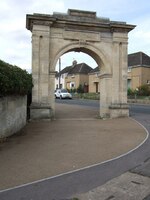 1834, Erection of Anti-Slavery Arch in Stroud
1834, Erection of Anti-Slavery Arch in Stroud -
1844, Relocation of the Blackboy Clock to Castle Street Paul Hawkins Fisher described the relocation of the clock in Notes and Recollections of Stroud (1871): "But, on the erection of the National School at the entrance of Castle-Street, in the year 1844, the clock and Black Boy, with his club and bell, were bought by subscription, and set up against the building. There the Boy has stood ever since, doing the duty of turning his head, lifting his club, and striking the hours of day and night as often as they come round; and there, it is hoped, he will for many years continue to perform his automatic exercises, to the wonder of strangers passing by, as he did to the admiration of boys and girls of old. But it has thereby come to pass that the identity, if not the very existence of the school, has been well-nigh lost in that of the Black Boy himself; inasmuch as a little girl being asked, “What school do you go to?” replied, “Please ma’am, I go to the Black Boy”; and this is the answer that all the children would give to the same question – “Please ma’am, I go to the Black Boy.” Indeed, it has been whispered that some high and grave authorities, whose duties often lead them to the Black Boy, call the school by the same name, to the great dismay of the purists in nomenclature, who prefer its less equivocal and , not doubt more accurate appellation of The School, (or the National School,) in Castle-street."
- 1847, Unveiling of the William Huskisson statue in Liverpool
-
1853, inauguration of the monument to Marshal Bugeaud On September 5, 1853, the monument to Marshal Bugeaud was inaugurated in the presence of numerous army representatives (including seven generals, staff colonel Trochu and staff squadron leader Vaubert de Genlis), politicians and senior civil servants, as well as a large crowd. The inauguration ceremony featured a number of speeches, followed by a balloon release and, in the evening, illuminations, fireworks and a cantata in honor of Bugeaud. Translated with DeepL.com (free version)
- 1854, Inauguration of the equestrian statue of Napoleon I
- 1856, Inauguration of the statue of Mahé de la Bourdonnais
-
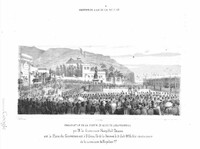 1856, Inauguration de la statue de Mahé de Labourdonnais. Lithographie de Antoine Louis Roussin, Album de l'Ile de la Réunion, Saint-Denis, A. Roussin, 1858.
1856, Inauguration de la statue de Mahé de Labourdonnais. Lithographie de Antoine Louis Roussin, Album de l'Ile de la Réunion, Saint-Denis, A. Roussin, 1858. -
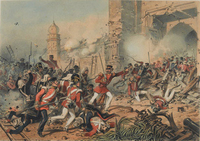 1857, Indian Rebellion A widespread rebellion across northern and central India against the oppressive rule of the British East India Company. It started with mutinies of Indian soldiers in the East India Company's armies, and escalated into widespread social uprising, including an attempt to reinstate Bahadur Shah Zafar, the Mughal emperor, as the effective ruler of India. The rebellion was suppressed with spectacular violence by the British governments in India and Britain, and ended with mass executions and exile, including of the last Mughal emperor, to Burma.
1857, Indian Rebellion A widespread rebellion across northern and central India against the oppressive rule of the British East India Company. It started with mutinies of Indian soldiers in the East India Company's armies, and escalated into widespread social uprising, including an attempt to reinstate Bahadur Shah Zafar, the Mughal emperor, as the effective ruler of India. The rebellion was suppressed with spectacular violence by the British governments in India and Britain, and ended with mass executions and exile, including of the last Mughal emperor, to Burma. -
1857, Meeting to plan a memorial to Lord Clive Several British politicians and public figures met in Princess's Hall, London, on the hundredth anniversary of the Battle of Plassey, to plan the creation of a memorial to Lord Clive. It was decided to form a committee to raise subscriptions to support the erection of a statue in a prominent location in Shrewsbury. During the meeting, Earl Stanhope said, 'That, inasmuch as the services of the great Lord Clive, the founder of the British Empire in the East, have not been commemmorated by any public monument, it is in the opinion of this meeting (assembled on the 100th anniversary of the victory of Plassy) desirable to record the national gratitude for those services by erecting a statue on some conspicuous site in Shrewsbury, the chief town of Lord Clive's native county.' Lord Dungannon noted that the aims of this activity was to honour of the virtues of the dead, as well as to 'excite the moral principles of the rising generation.' Expressing a vision of benevolent and paternalist empire, Mr Campbell Paterson noted that the 'defection' in the Indian army had been caused by a departure from Clive's own principles; that Indian soldiers should be treated with kindness rather than severity. A committee was formed consisting of the Lord Lieutenant and the High Sheriff of Shropshire, the President of the India Board, the Chairman of the East India Company, the members for Shrewsbury, the Duke of Cleveland, the Earl of Stanhope, Viscount Dungannon, Sir Robert Vivian, Sir Lawrence Peel, Sir James Hogg, Mr. W.B. Bagley, the Mayor of Shrewsbury, and the Rev. B.H. Kennedy D.D.
-
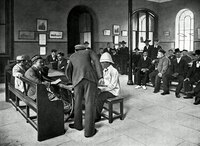 1857, The Strangers' Home opened in Limehouse, London
1857, The Strangers' Home opened in Limehouse, London -
1859, inauguration of the statue of Empress Josephine, Place de la Savane The statue was inaugurated with great fanfare during three days of festivities in Fort-de-France on August 29, 30 and 31, 1859. The splendor of the ceremony was enhanced by the presence of many distinguished guests, first and foremost the Governor of Guadeloupe and members of that colony's administration, but also many foreigners. Representatives from several neighboring islands were also present, including the British Governor of St. Lucia (an island south of Martinique), the British and Venezuelan Consuls, as well as delegations from the Danish islands of St. Thomas and St. Croix, Barbados and Grenada (British colonies). The inauguration was accompanied by an exhibition and agricultural competition to showcase Martinique's riches. Indeed, Governor Maussion de Candé claims that the event attracted many visitors to Fort-de-France, a number he estimates at around 10,000, in addition to the city's usual population. Last but not least, the inauguration gave rise to a great popular celebration, with fireworks, banquets and balls, in which all categories of the population seemed to take part, with games and dances lasting late into the evening for four days.
- 1859, Installation of the equestrian statue of Henry Hardinge in Kolkata, India
-
1860, Statue of Robert Clive unveiled at Shrewsbury At the inauguration of the statue of Robert Clive in Shrewsbury Market Square, several colonial officials who had played active roles in the Indian rebellion of 1857 gave emotional speeches. Herbert Edwardes gave as speech summarising his career, not omitting his conspiracies and his psychological disturbances, but concluded that in this career, there was 'much to honour, much to admire, much of which Englishmen must feel proud and thankful.'
-
1868, "Why be born a slave?" Bust of en enslaved woman by Jean-Baptiste Carpeaux Presented at the 1869 Salon, this bust expresses pain and revolt against the condition of slavery. It made a major impact in 1869 and beyond. It was reproduced in bronze but also in terracotta and plaster, and can be found in numerous museumsand private collections in France and elsewhere.
- 1869, Inauguration of General Leclerc Statue, Pontoise
-
1871, James Scott creates a mezzotint print of Robert Clive's portrait James Scott's print was based on James MacArdell's print, which in turn was based on Gainsborough's portrait of Robert Clive.
- 1875, Relocation of the Robert Milligan statue
-
1879, Inauguration de la statue de Jacques Coeur à Bourges Alors qu'une fête avait été organisée en hommage à Jacques Coeur en 1865, sa statue, livrée à la ville de Bourges en 1875, est mise en attente pendant quatre ans dans la cour de la bibliothèque municipale. En 1879, un piédestal est réalisé pour l'installer devant le palais Jacques Coeur. Son inauguration, le 15 mai 1879 ne fait cependant pas l'unanimité, notamment parce qu'elle exclut toute dimension religieuse et elle aurait attiré peu de public, selon la presse locale. A partir de 1882, la fête annuelle (en juin ou juillet) prend cependant le nom de Jacques Coeur.
- 1881, le buste "l'esclavage" d'Etcheto reçoit le premier prix au Salon annuel des artistes français
- 1882, Installation of the statue of John Lawrence in London
- 1887, Relocation of the statue of John Lawrence from the UK to India
-
1889, Inauguration de la statue de Paul Bert Parmi les invités officiels : les princes Mien-Trien et Quinh-Quac-Cong, des écoliers annamites et tonkinois, ministres, ambassadeurs, généraux, parlementaires, etc.
-
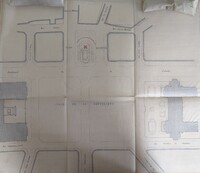 1890, Project of construction of Faidherbe Monument on Richebé Place, Plan Général. Lille municipal archives, 1M/2/57 Plan drawn up by the municipal works department of the city of Lille
1890, Project of construction of Faidherbe Monument on Richebé Place, Plan Général. Lille municipal archives, 1M/2/57 Plan drawn up by the municipal works department of the city of Lille -
1893, Decision to erect a monument to Olry The Nouméa town council voted to erect a monument to Olry, "considering that Admiral Olry rendered eminent services to the colony, the memory of which will always remain in the hearts of the colonists of New Caledonia; that he quelled an unprecedented insurrection".
-
1894, Statue of Edmund Burke unveiled in Bristol ‘Lord Rosebery came to Bristol to unveil the statue in October 1894. He had become the Prime Minister in March, when he took over from the 85-year-old Gladstone. Due to heavy rain, Roseberry delivered his address on the life and character of Burke and his connections with Bristol in the Colston Hall.’
-
1895, Statue of Edward Colston unveiled in Bristol statue of Colston unveiled by W. Howell Davies, Mayor of Bristol. This occurred on Colston Day, the birthday of Edward Colston, which had been celebrated in civic life since the 1840s. ‘the first modern memorial for Colston was created in 1846 on the replacement Guildhall in Broad Street’
-
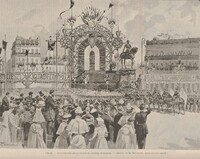 1896, Inauguration of the monument to General Faidherbe
The inauguration of the statue on October 25, 1896 was a very official event, organized by a "committee for the organization of the inauguration festivities", with the help of the army, for a budget of 1,500 Francs. The town hall, the prefecture and the committee issued invitations to numerous national political figures (the President of the Republic, who declined, the Minister of War, who attended) and to all the mayors of the region, the presidents of the chambers of commerce and the magistrates of the commercial court, as well as to numerous sports, musical, youth and veterans' societies. The inauguration of the statue was also a popular event, with large numbers of people attending the festivities. The festivities went off without a hitch, despite prior tensions between clerics and anticlerics, and between socialists and moderate republicans, all of whom claimed Faidherbe's legacy. The local and national press reported on the celebrations: ceremonies began at 10:30 a.m., with the mayor and town council welcoming 35 gymnastics societies, followed by parades and official speeches. The festivities lasted three days, from October 24 to 26, 1896, and included medal presentations, poetry recitals, the singing of a cantata in Faidherbe's honor, bomb and artillery firings, concerts, popular dances, illuminations.
1896, Inauguration of the monument to General Faidherbe
The inauguration of the statue on October 25, 1896 was a very official event, organized by a "committee for the organization of the inauguration festivities", with the help of the army, for a budget of 1,500 Francs. The town hall, the prefecture and the committee issued invitations to numerous national political figures (the President of the Republic, who declined, the Minister of War, who attended) and to all the mayors of the region, the presidents of the chambers of commerce and the magistrates of the commercial court, as well as to numerous sports, musical, youth and veterans' societies. The inauguration of the statue was also a popular event, with large numbers of people attending the festivities. The festivities went off without a hitch, despite prior tensions between clerics and anticlerics, and between socialists and moderate republicans, all of whom claimed Faidherbe's legacy. The local and national press reported on the celebrations: ceremonies began at 10:30 a.m., with the mayor and town council welcoming 35 gymnastics societies, followed by parades and official speeches. The festivities lasted three days, from October 24 to 26, 1896, and included medal presentations, poetry recitals, the singing of a cantata in Faidherbe's honor, bomb and artillery firings, concerts, popular dances, illuminations. -
1897, Inauguration de la statue d'Olry 1897, Inauguration of the statue of Olry
-
1897, Inauguration of the Victor Schœlcher monument in Cayenne L’inauguration est un événement très officiel. Sur la place Victor Hugo décorée de quatre arcs de triomphe recouverts de verdure, d’écussons, de drapeaux et d’oriflamme, une estrade est dressée pour accueillir le gouverneur Henri Eloi Danel (1896-1898), les membres du conseil privé, des fonctionnaires et officiers. Le gouverneur dévoile la statue symbolisant selon lui « la France accomplissant simplement, noblement, un grand acte de justice » et en fait don à la ville de Cayenne. La maire de Cayenne, Henri Ursleur (1890-1898), commence son discours en affirmant que « la Guyane s’est grandement honorée en prenant, la première de toutes les colonies, l’initiative de l’érection d’un monument à Victor Schœlcher ». Les enfants des écoles de la ville sont présents, drapeau à la main, et chantent des chants au cours de la cérémonie.
- 1897, le Musée des Beaux-Arts de Pau fait couler en bronze le buste "l'esclavage" d'Etcheto
-
1898, French soldiers face British army in Fachoda July 10, 1898: Mission Marchand moves to Fachoda on the White Nile after signing a treaty with Grand Mek Abd El Fadil, ruler of the Chillouks. September 19, 1898: General Kitchener's army arrives and demands that the French evacuate Fachoda. November 12, 1898: the Marchand mission withdrew, rejecting the British offer to pass through Egypt and opting instead for Djibouti.
- 1900, Installation of the statue of William Mackinnon in Mombasa, Kenya
- 1901, Buller Memorial Committee decides to create a memorial to Redvers Buller
-
1901, Creation of the Buller Memorial Committee in Exeter The Buller Memorial Committee was created in a meeting held in Exeter Guildhall in October 26th, 1901. The committee members were Albert Edward Dunn (Mayor of Exeter, 1900-1901), Edwin Charles Perry (Mayor of Exeter, 1904), J. A. Loram, T. Moulding, W. Wreford (Deputy Mayor of Exeter, 1901), E. J. Domville, T. Linscott (Mayor of Exeter, 1905), C. J. Ross, and W. H. Steer. October 1901 was a critical moment in Buller's own career and his subsequent legacy. Buller had come under heavy criticism from British newspapers for the Army's performance in the Second Boer War, and he was subsequently relieved of his army command on October 22nd, 1901. Given the Exeter meeting was held four days later, the campaign to build a statue for Buller was very much shaped around this controversy over his historical reputation.
- 1901, Local politicians in Exeter respond to the dismissal of Redvers Buller